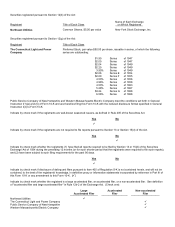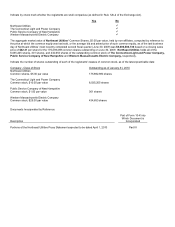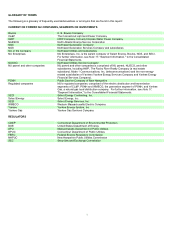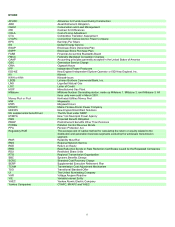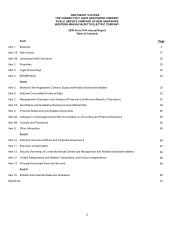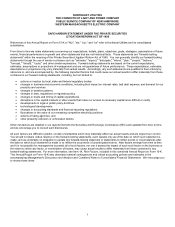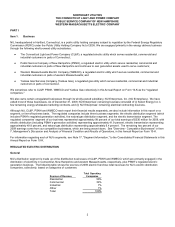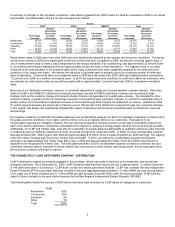Eversource 2009 Annual Report Download - page 14
Download and view the complete annual report
Please find page 14 of the 2009 Eversource annual report below. You can navigate through the pages in the report by either clicking on the pages listed below, or by using the keyword search tool below to find specific information within the annual report.
6
PSNH is constructing its Clean Air Project, a sulfur dioxide and mercury scrubber at its Merrimack coal-fired generation station,
currently expected to cost $457 million. The project is expected to be under budget and completed in mid-2012. PSNH will recover all
related costs through its ES rates. PSNH has spent approximately $146.8 million on the project to date, of which $119.3 million was
capitalized in 2009. Construction of the project was approximately 34 percent complete as of December 31, 2009.
Sources and Availability of Electric Power Supply
During 2009, about 67.7 percent of PSNH’s load was met through its own generation, long-term power supply provided pursuant to
orders of the NHPUC, and contracts with third parties. The remaining 32.3 percent of PSNH's load was met by short-term (less than
one year) purchases and spot purchases in the competitive New England wholesale power market. PSNH expects to meet its load
requirements in 2010 in a similar manner.
New Hampshire’s "Electric Renewable Portfolio Standard Act" establishes renewable portfolio standards (RPS) for electricity sold in the
state and requires annual increases in the percentage of the electricity sold to retail customers having direct ties to renewable sources.
The renewable sourcing requirements began in 2008 and increase each year to reach 23.8 percent by 2025. For each MWh of energy
produced from a qualifying resource, the producer will receive one REC. Energy suppliers, like PSNH, purchase RECs from these
producers and use them to satisfy the RPS requirements. PSNH also owns renewable sources and uses internally generated RECs in
meeting its RPS obligations. To the extent that PSNH is unable to purchase sufficient RECs, it makes up the difference between the
RECs purchased and its total obligation by making an alternative compliance payment (ACP) for each REC requirement for which
PSNH is deficient. The costs of both the RECs and ACPs do not impact earnings, as these costs are recovered by PSNH through its
ES rates. For further information, see "Regulatory Developments and Rate Matters" in Item 7, Management's Discussion and Analysis
of Financial Condition and Results of Operations, in this Annual Report on Form 10-K.
WESTERN MASSACHUSETTS ELECTRIC COMPANY - DISTRIBUTION
WMECO’s distribution segment is engaged in the purchase, delivery and sale of electricity to residential, commercial and industrial
customers. At December 31, 2009, WMECO furnished retail franchise electric service to approximately 205,000 retail customers in 59
cities and towns in the western third of Massachusetts. WMECO does not own any electricity generating facilities. WMECO has
contracts with two IPPs, the output of which WMECO sells into the market.
The following table shows the sources of 2009 electric franchise retail revenues based on categories of customers:
WMECO
Residential 58%
Commercial 32%
Industrial 9%
Other 1%
Total 100%
Rates
WMECO is subject to regulation by the Massachusetts Department of Public Utilities (DPU), which has jurisdiction over, among other
things, rates, accounting procedures, certain dispositions of property and plant, mergers and consolidations, issuances of long-term
securities, acquisition of securities, standards of service, management efficiency and construction and operation of distribution,
production and storage facilities. WMECO's present general rate structure consists of various rate and service classifications covering
residential, commercial and industrial services. Massachusetts utilities are entitled under state law to charge rates that are sufficient to
allow them an opportunity to cover their reasonable operation and capital costs, to attract needed capital and maintain their financial
integrity, while also protecting relevant public interests.
Under state law, all of WMECO's customers are now entitled to choose their energy suppliers, while WMECO remains their distribution
company. WMECO purchases electric power for and passes through the cost to those customers who do not choose a competitive
energy supplier (basic service). Basic service charges are adjusted and reconciled on an annual basis. Most of WMECO's residential
and smaller customers have continued to buy their power from WMECO at basic service rates. A greater proportion of large
commercial and business customers have opted for a competitive energy supplier.
WMECO recovers certain costs through various tracking mechanisms in its retail rates, including transmission costs and prudently
incurred stranded costs (a portion of which have been financed through securitization by issuing RRBs) with periodic true-up
adjustments. The last such adjustment, effective January 1, 2010, resulted in a 3.7 percent increase in customer rates.
On September 2, 2008, WMECO notified the DPU that it expects to file its next distribution rate case in mid-2010 to be effective January
1, 2011. That case will include a proposal to fully decouple distribution revenues from Kilowatt-hours (KWh) sales in compliance with
the DPU’s July 16, 2008 decision in a generic decoupling docket. We expect a decision from the DPU by the end of 2010.


